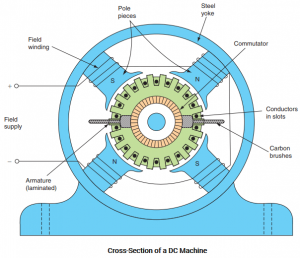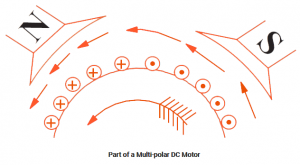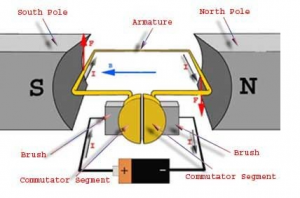DC Motor is a two-wire continuous rotation motor and the two wires are power and ground. When the supply is applied, a DC motor will start rotating until that power is detached. Most of the DC motors run at high revolutions per minute (RPM), examples are; fans being used in computers for cooling or car wheels controlled by radio.

The DC motor speed can be controlled by using PWM (pulse width modulation) technique, a technique of fast pulsing the power ON & OFF. The percentage of time consumed cycling the ON/OFF ratio defines the motor’s speed. For e.g. if the power is driven at 50%, then the DC motor will rotate at half the speed of 100%. Each pulse is so fast that the motor seems to be nonstop spinning with no faltering
Real-Time Application of DC Motor with Arduino Refer to the video given below:
Operation principle of a DC Motor
- A DC motor is an electrical machine that converts electrical energy into mechanical energy.
- The working of the DC motor is based on the principle that when a current-carrying conductor is placed in a magnetic field, it experiences a mechanical force.
- The direction of the mechanical force is given by Fleming’s Left-hand Rule and its magnitude is given by F = BIL Newton.
- The working of the AC motor (Induction motor and Synchronous Motor) is different from the DC motor.
- There is no basic difference in the construction of a DC generator and a DC motor. In fact, the same DC machine can be used interchangeably as a generator or as a motor.
- Like generators, there are different types of DC motors which are also classified into shunt-wound, series-wound, and compound-wound dc motors.
- DC motors are seldom used in ordinary applications because all-electric supply companies furnish alternating current.
- However, for special applications such as in steel mills, mines, and electric trains, it is advantageous to convert alternating current into direct current in order to use dc motors. The reason is that the speed/torque characteristics of DC motors are much superior to that of AC motors.
- Therefore, it is not surprising to note that for industrial drives, DC motors are as popular as three-phase induction motors.
Working of DC Motor

Consider a part of a multipolar DC motor as shown in the figure below. When the terminals of the motor are connected to an external source of DC supply:
- the field magnets are excited about developing alternate North and South poles
- the armature conductors carry currents.

All conductors under North-pole carry currents in one direction while all the conductors under South-pole carry currents in the opposite direction. The armature conductors under N-pole carry currents into the plane of the paper (denoted as ⊗ in the figure). And the conductors under S-pole carry currents out of the plane of the paper (denoted as ⨀ in the figure). Since each armature conductor is carrying current and is placed in the magnetic field, a mechanical force acts on it. On applying Fleming’s left-hand rule, it is clear that force on each conductor is tending to rotate the armature in the anticlockwise direction. All these forces add together to produce a driving torque that sets the armature rotates.
When the conductor moves from one side of a brush to the other, the current in that conductor is reversed. At the same time, it comes under the influence of the next pole which is of opposite polarity. Consequently, the direction of the force on the conductor remains the same.
It should be noted that the function of a commutator in the motor is the same as in a generator. Reversing current in each conductor as it passes from one pole to another, helps to develop a continuous and unidirectional torque. Advantages of DC Motor
Advantages of DC Motor
- Provide excellent speed control for acceleration and deceleration
- Easy to understand design
- Simple, cheap drive design











